- | 3:00 pm
This humble chair kickstarted the sustainable-design revolution
Designer Jane Atfield brought recycled plastic into furniture design in the ‘90s. She’s ready for the industry to finally catch up.
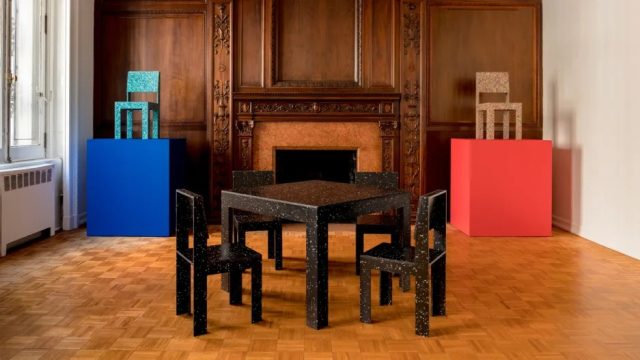
In a world where everything from shampoo bottles to playground equipment to leggings are made from recycled plastic, it’s hard to believe there was a time when the material wasn’t ubiquitous. But when British designer Jane Atfield created a chair made entirely of post-consumer recycled plastic in 1992, the idea felt positively revolutionary.

[Photo: courtesy Emma Scully Gallery]
Called the RCP2, Atfield’s chair was made of colorful plastic bottles that had been chipped and compressed into boards—a simple but groundbreaking idea that earned her a spot in design history. Now, 30 years after the RCP2’s creation, Atfield is partnering with New York City gallerist Emma Scully to create a limited reissue of the seminal design.

Jane Atfield [Photo: courtesy Emma Scully Gallery]
Atfield was a student at the Royal College of Art (RCA) when she came across a sample piece of board made from plastic bottles, created by the Missouri-based plastics recycler Yemm & Hart. It was the first time she’d seen anything like it. While people in the early ’90s were starting to be aware of the problems created by plastic pollution, she’d never encountered anyone who was making things out of used plastic in the U.K. or Europe. Entranced by the material, she had some of it shipped across the Atlantic in the hopes of using it to create furniture.
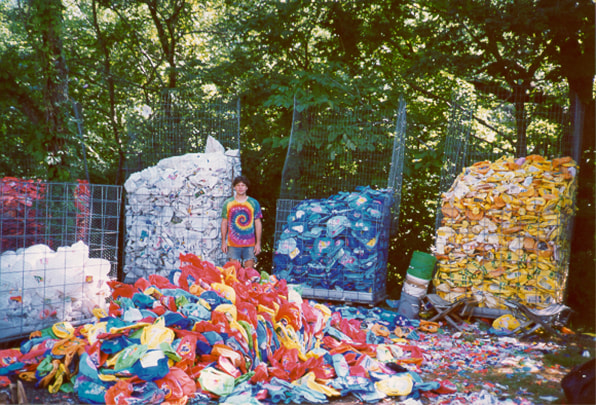
[Photo: courtesy Emma Scully Gallery]
“I wanted to celebrate the material itself, and the message in the material, which was to . . . make a connection between waste and consumerism,” she says now. “It was the vehicle to explore social and environmental themes within furniture because most furniture wasn’t speaking about those things at that time.”
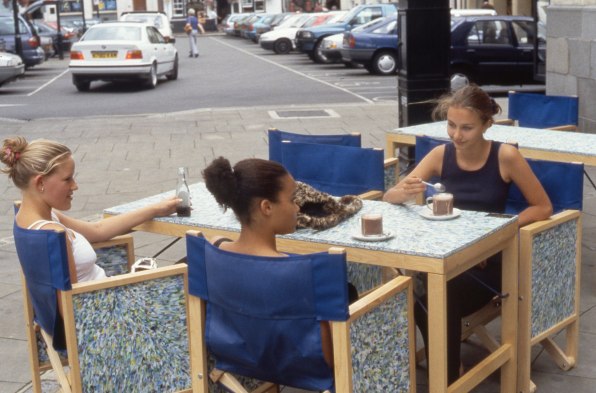
Newbury Corn Exchange Outdoor Cafe chairs and tables from Made of Waste recycled plastic, ash, canvas, 1996. [Photo: Jane Atfield/courtesy Emma Scully Gallery]
The result of those reflections was the RCP2 chair, presented as part of her graduation showcase. Inspired by Gerrit Rietveld’s iconic crate chair, which had a boxy shape and used castaway materials, Atfield’s design featured clean lines and a simple silhouette that intentionally focused the eye on the material itself. The recycled plastic board was so vibrant that some viewers thought it was painted, flecked as it was with the colors of the bottles and the fragments of their labels still recognizably contained within.
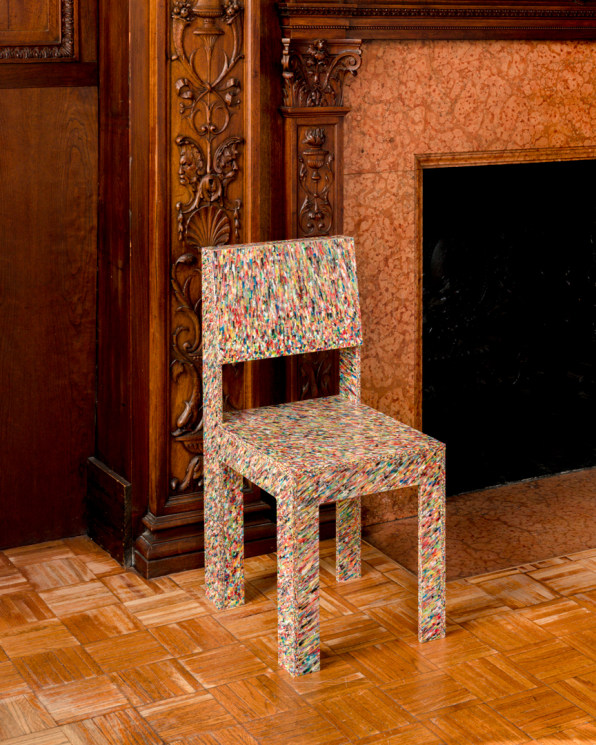
[Photo: Sean Davidson/courtesy Emma Scully Gallery]
Though Atfield never made more than 60 copies of the chair, it was a groundbreaking contribution to the evolution of furniture design, and one that Atfield has been widely recognized for since: versions of the RCP2 are part of the permanent collections at the V&A Museum and the Design Museum of London, and the chair has been included in volumes about design by such publishers as Taschen.
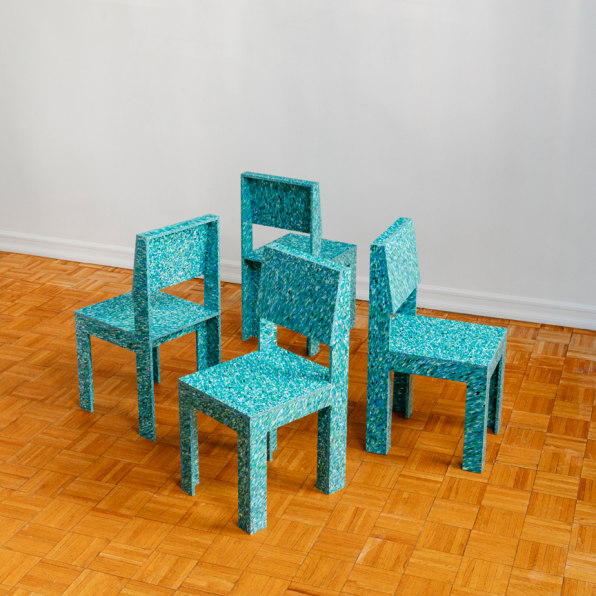
[Photo: Sean Davidson/courtesy Emma Scully Gallery]
“The RCP2 chair wears its heart on its sleeve, insofar as the design puts the post-consumer recycled-plastic material center stage. It is a polemical manifesto about alternative design values,” says Gareth Williams, the curator who purchased the chair for the V&A in 1996, who is now a professor of design at Middlesex University. “This deliberate decision to shout loudly about the green credentials of this chair situates it in a time and place. Environmentally sustainable design was still in its infancy, so the point had to be made with force.”
It was a point that Atfield continued to pursue beyond the creation of RCP2. She went on to found Made of Waste, an agency for recycled materials dedicated to taking Yemm & Hart’s idea of turning trash into new materials and adapting it for British waste streams. At a time when recycling infrastructure in London was still being developed, Atfield dedicated herself to finding and repurposing everything from Marks & Spencer coat hangers to used plastic wrap from catering companies.
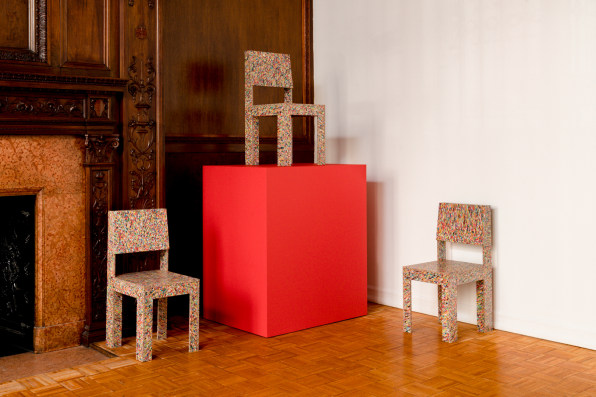
[Photo: Sean Davidson/courtesy Emma Scully Gallery]
It’s Atfield’s lasting legacy as a “pioneering eco-designer” that convinced Scully to partner with her this year and release a limited reedition of the RCP2 chair as a collector’s item, which is being sold for $3,500.“This was a really critical contribution, intellectually, to the history of design,” says Scully. “It was at the forefront of thought about how to tackle post-consumer waste.”
For her part, Atfield is glad to see the ways in which recycled plastic has become more mainstream in the three decades since she created the RCP2. But, she says, ultimately, she dreams of a world in which there’s less plastic, period, and where governments step in to regulate the material so that it’s not overproduced. If plastic is going to be used, she thinks it should be primarily in medical applications or other cases where nothing else will do.
As long as we’re in this period in which too much plastic is still being created, though, she sees recycling as a transitional solution and hopes the RCP2 can play a role in inspiring people to get creative with waste.
“I still can’t quite reconcile the lack of urgency, particularly within the industry and manufacturers,” she says, “but we’re moving in the right direction.”






































